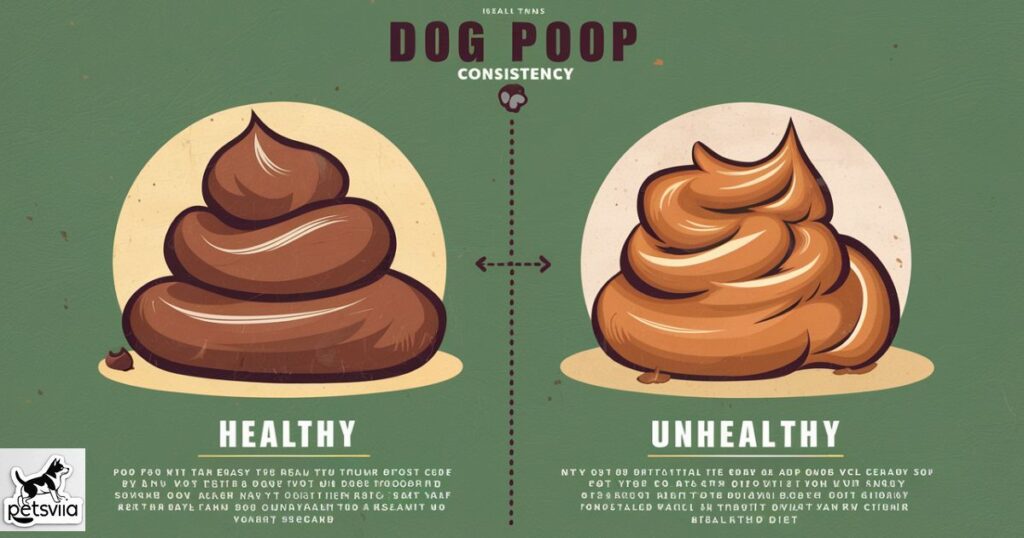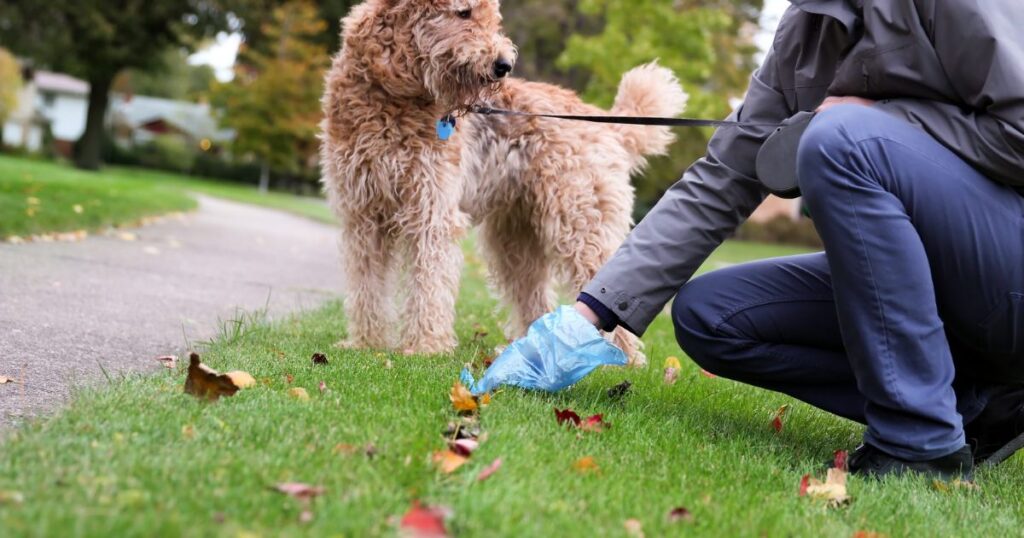Checking your furry friend’s poop may seem like a cringe-worthy task, but it’s actually a goldmine of information about their overall health and digestion.
Don’t just scoop and scurry – take a moment to inspect those bowel movements! Changes in color, consistency, coating, and contents can provide early warning signs of potential issues.
While diet changes can temporarily affect your dog’s stool, prolonged abnormalities should be monitored closely. This comprehensive guide is your ultimate resource for decoding your pup’s poop, understanding what’s normal, and recognizing when it’s time to seek veterinary care.
What Should Healthy Dog Poop Look Like?

The ideal healthy dog poop should be:
- Color: Brown (ranging from light to dark shades)
- Consistency: Firm but pliable, formed into segmented logs
- Shape: Easy to scoop up without smearing or sticking to surfaces
As a general rule, dogs should have bowel movements anywhere from 1 to 5 times per day, with the amount proportional to their food intake. If your pup is pooping more frequently, it’s worth keeping an eye on.
Dog Poop Colour Meanings
While brown is the standard healthy hue, your dog’s poop can vary in color based on their diet and other factors. Understanding these different shades is key to identifying potential health issues.
Brown Dog Poop
Brown is the normal, desirable color for dog stool. No need for concern here!
Green Dog Poop
A greenish tint could mean:
- Your pup has been snacking on grass, which can sometimes signal stomach troubles
- Their diet contains green-colored foods like vegetables
Unless it persists for several days, green dog poop is usually nothing to worry about. If you notice other concerning symptoms, collect a fresh sample and contact your vet.
Read More :
10 Reasons Why Shih Tzus Are The Worst Dogs Breed To Own
Yellow or Orange Dog Poop
Common causes of yellow or orange canine scat include:
- Dietary changes or new ingredients like carrots, sweet potatoes, or turmeric
- Adjusting to a new dog food formula
These colors are typically harmless and temporary as your dog’s system adapts. But if the discoloration persists for more than a week, it’s a good idea to get your vet’s opinion.
Red, Pink or Magenta Dog Poop
Bright red blood in dog stool could indicate a serious condition like hemorrhagic gastroenteritis, which can be fatal if left untreated. Your dog needs immediate veterinary attention.
A pinkish or reddish tinge might be caused by:
- Colitis (colon inflammation)
- Intestinal parasites
- Polyps or other gastrointestinal issues
While not necessarily an emergency, any red in your dog’s poop warrants a trip to the vet to identify the underlying cause.
Black Dog Poop
Black, tarry stool is a sign of old blood in the upper gastrointestinal tract, which could indicate an ulcer, tumor, or other serious condition. See your vet right away if you notice this.
Gray Dog Poop
A grayish color and greasy, foul-smelling appearance could mean your dog has pancreatic issues affecting their ability to properly digest and absorb nutrients from their food.
White Dog Poop
Occasional white chunks or streaks in dog poop may simply indicate your pup is constipated or consuming too much calcium (common with raw diets containing bones).
If you also see small white worms or rice-like segments, this is likely due to intestinal parasites like roundworms or tapeworms. Your vet can prescribe the appropriate deworming medication.
Blue Dog Poop
This very abnormal color is rare but could signal your dog has ingested a toxic substance or non-food item like rocks, toys, or poisonous plants. Contact your vet immediately if you notice blue-tinted stool.
Healthy vs Unhealthy Dog Poop Consistency

Aside from color, poop firmness and texture are crucial factors in assessing your dog’s digestive health. Here’s a quick overview:
Ideal Poop Consistency:
- Firm and formed into segmented logs
- Pliable without being too hard or too soft
- Easy to scoop up without leaving residue
You can refer to the Bristol Stool Chart for a helpful visual guide on stool firmness. While soft poop isn’t necessarily abnormal, pay attention to these more concerning consistencies:
Hard Dog Poop
Extremely hard, pellet-like stools could be a sign of:
- Constipation
- Dehydration
- Lack of fiber in your dog’s diet
Occasional hard poop may not be cause for alarm. , if it becomes a recurring issue not solved by increasing water and fiber intake, it could indicate an underlying digestive disorder requiring veterinary care.
Runny or Watery Dog Poop
Watery stool, also known as diarrhea, has many potential causes:
- Dietary indiscretion or sudden food changes
- Stress or anxiety
- Viral, bacterial or parasitic infections like giardia
- Inflammatory bowel disease
- Other illnesses
While diarrhea in dogs lasting less than 24 hours may resolve on its own, loose stools persisting beyond a day could lead to dehydration. Watch for signs of pain or discomfort, and contact your vet if diarrhea is accompanied by:
- Blood in the stool
- Lethargy
- Loss of appetite
- Vomiting
Dog Poop Contents and When to Be Concerned
In addition to color and consistency, it’s important to inspect the actual contents of your dog’s bowel movements. Some abnormal findings that warrant attention include:
Undigested Food
Seeing the occasional undigested piece of kibble or vegetable matter is normal. , large amounts of undigested food in dog poop could signal:
- Food is moving too quickly through the digestive tract
- Your dog is eating too much or too quickly
- Potential malabsorption or digestive issues
Hair
It’s common to find small clumps of your dog’s fur in their stool, especially if they’re a heavy shedder. But excessive hair could mean your pup is compulsively grooming due to allergies, anxiety, or boredom. In rare cases, large fur accumulations can cause intestinal blockages.
Intestinal Parasites
Worms and other intestinal parasites can wreak havoc on your dog’s gastrointestinal health. Signs to look for include:
- White, rice-like segments
- Small, thread-like worms
- Egg casings
If you suspect worms in dog poop, collect a fresh sample and schedule a vet appointment. Your dog will likely need deworming medication to eliminate the parasites.
Foreign Objects
Dogs are notorious for eating things they shouldn’t – from socks and toys to rocks and bones. Non-digestible objects in their stool could signify:
- Intestinal blockage
- Lacerations or injuries along the digestive tract
If you spot any foreign bodies, contact your vet immediately, as these can cause serious, potentially fatal complications.
Should My Dog’s Poop Have a Slimy Coating?
While small amounts of mucus are normal and help lubricate the digestive tract, excessive slime or mucus in dog poop is a red flag. This abnormal finding could indicate:
- Inflammation in the gastrointestinal tract
- Bacterial or viral infections
- Inflammatory bowel disease
The mucus may be yellow or tinged with blood, and the stool will likely have an unusual slimy texture, as seen in this image:
If you notice excessive mucus, foul odors, or other concerning symptoms like lethargy or loss of appetite, make a vet appointment promptly.
What Should Healthy Dog Poop Smell Like?
Let’s be real – dog poop is never going to smell like roses. A typical healthy stool will have a pungent, characteristically unpleasant aroma.
If the odor is overwhelmingly foul or much worse than usual, it could indicate:
- Intestinal parasites like giardia
- Malabsorption or digestion issues
- Bacterial or viral infections
An abnormally strong, rancid odor may also accompany other symptoms like:
- Flatulence (excessive gassiness)
- Diarrhea
- Vomiting
While not necessarily an emergency, persistently foul-smelling poop warrants a trip to the vet to identify and treat the underlying cause.
When to Call the Vet About Your Dog’s Poop

Most temporary poop changes related to diet are nothing to panic about. You should seek veterinary guidance if you notice any of the following:
Diarrhea Lasting Over 2 Days Prolonged diarrhea can quickly lead to dehydration and other complications, especially in puppies.
Blood or Excessive Mucus in Stool
These can indicate parasites, inflammation, or other gastrointestinal issues requiring medical treatment.
Grey, Greasy Stools This abnormal appearance may signal an inability to properly digest and absorb nutrients (malabsorption).
Suspected Blockage If you suspect your dog has ingested a foreign object that’s now stuck in their digestive tract, don’t delay getting help. Intestinal blockages are life-threatening emergencies.
Other Illness Signs Additional symptoms like lethargy, vomiting, loss of appetite, or abdominal pain/discomfort warrant a vet visit, as these could be signs of serious underlying conditions.
The bottom line? While some poop variations are normal, any dramatic or persistent changes call for professional assessment to ensure your dog’s long-term health and wellbeing.
How to Collect a Dog Stool Sample
If your vet requests a stool sample to aid in diagnosis, here’s the proper way to collect it:
- Use a Sealable Plastic Bag or Container
This prevents contamination and leakage. Avoid using anything absorbent like paper towels. - Collect Fresh Poop Dog
The sample should be as fresh as possible, ideally within 6-8 hours of your appointment. - Pick Up Just the Stool
Try not to collect any grass, leaves, or other debris. - Chill It If Needed If you can’t get to the vet right away, you can refrigerate the sample for a short period. Just don’t freeze it.
- Double Bag for Transport Place the stool sample bag inside another sealable bag to prevent leaks.
Handling dog poop directly increases your risk of exposure to harmful bacteria or parasites. Always wear disposable gloves and wash your hands thoroughly afterwards.
The Final Scoop
Monitoring your dog’s bowel movements may not be the most glamorous part of pet parenthood, but it’s an essential step in keeping them healthy and detecting any potential issues early on.
To quickly recap the key points:
- Normal, healthy poop should be brown, formed and firm (but not rock-hard), with no excessive odor or undigested contents.
- Abnormal colors, consistencies, or coatings (like mucus) can signify anything from dietary changes to serious medical conditions like bacterial infections or cancer.
- Foreign objects, worms, or large objects indicate the need for prompt veterinary attention.
- Persistent diarrhea, constipation, vomiting, or lethargy accompanying abnormal stools also warrant a trip to the vet.
While some temporary variation in your dog’s stool is normal (especially after diet swaps), don’t ignore dramatic or long-lasting changes. Regular monitoring and care can improve your pup’s digestive health and overall wellbeing.
If you’re ever unsure or concerned about your poop dog, don’t hesitate to contact your vet. A professional opinion can provide peace of mind and ensure any developing issues are addressed quickly and properly.







